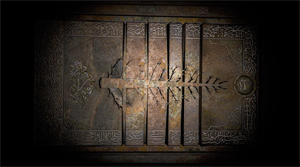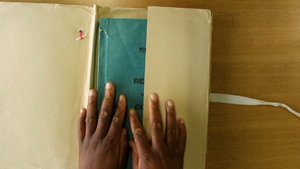Women, Life, and Freedom
John Haberin New York City
Barbad Golshiri and Onyeka Igwe
A man and woman in the prime of life stand behind and to either side of a seated woman, tending ever so slowly to her hair. No one takes pleasure in the grooming. The video is In Mourning, and they could be preparing a corpse for its final display.
In reality, the artist and his sister are in mourning, but not for their mother in the chair. They have lost their father, and custom requires that the widow appear in black, right down to the dye in her hair. The entire show is "Of Mourning and Revolt," and for Barbad Golshiri these go together, in a time of repression and upheaval in Iran. Which will win out? Where other artists cannot stop thrusting their curriculum vitae on everyone and anyone, Golshiri sees this as his curriculum mortis. In what others have called the Woman, Life, Freedom Revolution, he sees only the "politics of death." 
Can there be such a thing? After Golshiri's show of public protest in Chelsea, you may find yourself wanting to ask: how does video art differ from theater? For starters, you may enter with the houselights already down—and yourself right in the middle of the action, however slow. Not that Onyeka Igwe in Nigeria will have you stumbling in the dark, at MoMA PS1. She leaves no doubt about right and wrong with A Repertoire of Protest (No Dance, No Palaver).
She leaves no doubt, too, that Iran's is not the first women's war. It is doubly chastening after the GOP's war on women in the United States. True, much of it centers on dancers, and the protesters themselves might well be dancing. Still, they are standing up for themselves as best they can. As I entered, I was watching African boys caught up in their own jerky rhythms. I was listening to a voice marveling at what she saw, but also struggling to take it all in.
In mourning for life
In Mourning takes place in 2014, the year of "Iran Modern" at Asia Society, and Barbad Golshiri picks up where an earlier show at the gallery left off the year before. This one sticks to photographs and video, but both are unrelentingly still. Something has changed in ten years, as a hotbed of creative art has broken out into street protests, led by women. Still, many a work conflates past and present. The words of a dissident, describing his torture, ring out through another after his death. The ornate face of a tomb at Persepolis could be the fine binding of a sacred text.
Here mourning and revolt alike involve the body, especially a woman's hair. The closest Golshiri comes to humor is giving himself an ablution, or ritual bath. And the closest he comes to optimism is a young woman with a raised arm, her pose familiar from who knows many generations of political posters and Arab springs. She holds strands of her hair in one hand, the photo of a murdered activist in the other. A monitor on the floor shows more wisps of hair, cut off in violation of Islamic fundamentalism, but they seem as wavering and fragile as revolution. Like Masha in Anton Chekhov's The Seagull, they are in mourning for life.
For Golshiri, east can meet west, but the encounter may be lethal. In his past show, marble slabs overlapped like fallen dominoes, as Death Sentence. Scrap metal and ashes filled an industrial trough inscribed with the name Beckett, in a dark memorial to the darkest of writers, and Golshiri himself consigned paper to the flames. Also face up on the floor lay rough stones, rusted iron, a barrel too well sealed for sustenance or water, and a skull staring at its own reflection. With so much solemn variety, it might be stretching things to say that he makes only tombstones, but he turned the gallery nonetheless into a graveyard.
For him the gravest of encounters end in silence. The face of the barrel reproduced Virgin and Child with Canon van der Paele by Jan van Eyck, in which the jowled canon can barely maintain his frozen smile even in contemplation. Here, though, the painting shares a holy space with a hooded figure in the hush before torture. Without a tapestry or celestial throne, its arched windows admit emptiness rather than light. Across the floor, Jan receives in tribute that low arc of rusted iron. The sole inscription on both is in braille, leaving mute voices to supply translation.
As editor of the works of Samuel Beckett, Golshiri's sympathies are with the translators—between East and West, Persian and English, authority and trust. One of the two jagged stones is already his tomb, with the other for the assassinated translator of Jorge Luis Borges, although Iran attributed the death to cardiac arrest. For his most makeshift grave marker, Golshiri pares away the greatest of Muslim commands: there is no god but God. It becomes a no less unaccommodating epitaph, No God. There may be no final and faithful translation, but there can be wiser ones, and wisdom comes in recovering the weight of words.
He is still translating, and the new show includes a glimpse of Last Judgment by Hieronymus Bosch, as if there were not enough judgments on hand. Still, he is harder than ever to read under western eyes. His images are not easy to decipher, even with help from the gallery. But then the present moment is not easy to read either. As Golshiri titles the wisps of hair, What Has Befallen Us, Barbad? One will just have to accept the puzzlement as wrapped up in the promises and pain.
Dancing in the dark
Like many today, Onyeka Igwe may be struggling to find a heritage. A London artist, she bases a trilogy of short films on the 1929 Aba Women's War, a rebellion against colonialism that brought instant reprisals. If you have never heard of it, physical evidence is nonexistent and accounts at the time are few and far between. Igwe takes pride in it all the same. She sees it, says the museum, as her "progressive origin story," one that asserts the "multiplicities of contemporary life" and "contests Western ideology's singular."  It also stares right back at the colonizer, the British Empire.
It also stares right back at the colonizer, the British Empire.
As for palaver, a politically correct chatbot could have written the wall text. (Actual chatbots sound a lot more sinister, but they are learning from the wrong data set, the world online.) If AI has you scared that it will put you out of work, the first to go at this rate may be museum curators—and never mind Harold Cohen and AARON in AI on canvas or a squishy AI tour of MoMA by Refik Anadol. Still, Igwe's point of view is more multiple than dogmatic. Who, say, was speaking to me? Her British accent might belong to an anthropologist, a colonizer, or the artist herself.
Any one of them might hope to bridge the distance between continents and centuries, with objectivity and love. When Vivian Browne, Tunji Adeniyi-Jones, and Yashua Klos turn to Central Africa only to find their western roots, they are doing much the same. Video itself has its share of time and space travelers, like John Akomfrah. Who among them would not be stumbling in the dark? I really had entered in the middle—the second of three parts in Igwe's "expanded cinema," about six minutes apiece. They have a narrative arc, but take them in whatever order you happen to find.
Each part opens with an animated dance, from a stick figure on five black screens, before closing in on the real thing. The first plays out on a small monitor, where a hand turns the pages of a book, in search of a vocabulary and a name. Another woman dresses for now, in a t-shift, even as its colors evoke the past. The second part is all dance. Its three channels cut back and forth between the boys and solo modern dancers, standing up or lying down. The last shows a gathering of women in the present, but in memory of protests past.
What MoMA calls "rhythmic editing," still photos and choppy video in black and white, lends the feel of archival footage. Color brings things back to the present, sadder but wiser. So does text, in which the artist keeps asking: is this how you wish to be framed and to be shot? Igwe may never fully overcome the air of AI PC, but she challenges the boundaries between recognition and recreation. Maybe memory is always recreation.
Trans-continental memory plays out everywhere at MoMA PS1, even after its shows this winter of Frieda Toranzo Jaeger, Umar Rashid, and Jumana Manna have closed. Downstairs in the two-level gallery, Chuquimamani-Condori and Joshua Chuquimia Crampton present a cross between a mural and a shrine. Siblings, they pay tribute to their great great-grandparents in Brazil, ancient wisdom, and "queer medicine" today. One can only hope that indigenous Aymara cosmologies have the same tolerance as their native California. Their rhythmic background music is provocative and entertaining all the same, as is the mural's colorful, makeshift imagery—of tigers, booze, a boom box, hearts filled with what might be guts, pilgrims, and an Iron Man mask as their god. Now if only it left you nearly long enough in the dark.

Barbad Golshiri ran at Thomas Erben through October 26, 2014, and April 7, 2023. Onyeka Igwe ran at MoMA PS1 through August 21, 2023, Chuquimamani-Condori and Joshua Chuquimia Crampton through October 2.




